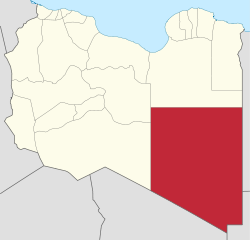Kufra District
Kufra | |
|---|---|
 Kufra in 1930 | |
 Map of Libya with Kufra district highlighted | |
| Country | Libya |
| Capital | Al Jawf |
| Area | |
| • Total | 453,611 km2 (175,140 sq mi) |
| Population (2006[1]) | |
| • Total | 50,104 |
| License Plate Code | 20 |
Kufra, Kufrah or Kofra (
History
The name Kufra (comes from Kufuh and Epher) itself is a derivation from
Geography
Kufra's location in Libya's southeast places it on the country's border with
Per 2006 census, there were totally 13,313 economically active people in the district. There were 6,295 government employees, 2,178 employers, 6,454 first level workers, and 1 second level worker. There were 85 workers in state administration, 85 in agriculture, animal husbandry and forestry, 2,445 in agriculture and hunting, 2,029 in education, 1,558 in private enterprises, 584 in health and social work, 85 in production, 2,214 in technical work, and 354 service workers. The total enrollment in schools was 17,364 and the number of people above secondary stage and less than graduation was 875.[8] As per the report from World Health Organization (WHO), there was one communicable disease centre, one dental clinic, one general clinic, three out-patient clinics, five pharmacies, 16 PHC centres, one rural clinic, and no specialized clinics.[9]
Local administration
During 2007, the northern part of Kufra District was moved to the newly created
Notes
- ^ "Districts of libya". statoids.com. Retrieved 27 October 2009.
- ISBN 0-8225-2549-6.
- ^ Friedrich Gerhard Rohlfs, Reise von Tripolis nach der Oase Kufra (1881).[1]
- ISBN 9780521337670.
- ISBN 9780816072293.
- ^ a b "Libya profile". 2016. Retrieved 23 November 2016.
- ISBN 9783540464631.
- ^ "Census of Libya". General Information Authority, Libya. 2012. Retrieved 17 November 2016.
- ^ "Health statistics of Libya". World Health Organization (WHO). 2007. Retrieved 17 November 2016.
- ^ Bertarelli 1929, p. 515.
- ^ "Libya profile - Timeline". BBC. 2 August 2016. Retrieved 20 November 2016.
- ^ Great Socialist People's Libyan Arag Jamahiriya Public Administration and Country profile (PDF) (Report). Department of Economic and Social Affairs (DESA), United Nations. 2004. p. 9. Archived from the original (PDF) on 9 February 2017. Retrieved 17 November 2016.
References
- Bertarelli, L.V. (1929). Guida d'Italia, Vol. XVII (in Italian). Milano: Consociazione Turistica Italiana.
